Vacuuming
Sep 5, 2013
Sep 5, 2013
Sep 6, 2013
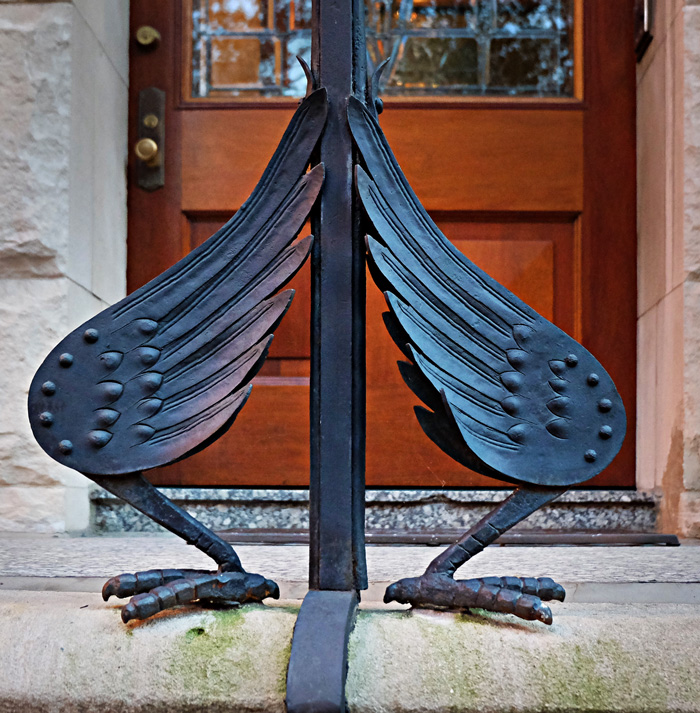 The railing on the stoop in front of this Rittenhouse Square dentist's office is held up by wrought iron wings and drumsticks.
The railing on the stoop in front of this Rittenhouse Square dentist's office is held up by wrought iron wings and drumsticks.
Sep 21, 2013
Sep 26, 2013
 We're told the egg may hatch soon. Watch this space for updates.
We're told the egg may hatch soon. Watch this space for updates.
Sep 27, 2013
 Seems this bird is in intensive care at BWI airport.
Seems this bird is in intensive care at BWI airport.
Sep 30, 2013
 Paganini the little poodle sits up in bed.
Paganini the little poodle sits up in bed.
Oct 1, 2013
 On one of these cranes in the sky above Bethesda, Maryland, is a "Now Selling" sign, urging people to go ahead and put their money down for new condos currently under construction.
On one of these cranes in the sky above Bethesda, Maryland, is a "Now Selling" sign, urging people to go ahead and put their money down for new condos currently under construction.
Odds are, however, that nobody's buying the condos–or much of anything else–in Bethesda or elsewhere in the Washington area this week. An estimated 700,000 people anticipate being furloughed for an unknown length of time, and hundreds of thousands more will be expected to do their work as usual except without any guarantee of a paycheck.
This is how we roll nowadays, in the greatest country on earth. . . .
The cranes will likely keep on craning, like other non-governmental operations, at least until the reduced level of spending in the regional economy pushes businesspeople to furlough even more employees.
Oct 7, 2013
 In the shop window of L.K. Jikson's on South 20th Street, a few blocks from Rittenhouse Square, stands a woman wearing a dress made of fabric printed in chartreuse, orange, and maroon. Click on the picture to see an enlarged view: the maroon shapes in the print are actually jet airliners.
In the shop window of L.K. Jikson's on South 20th Street, a few blocks from Rittenhouse Square, stands a woman wearing a dress made of fabric printed in chartreuse, orange, and maroon. Click on the picture to see an enlarged view: the maroon shapes in the print are actually jet airliners.
Oct 9, 2013
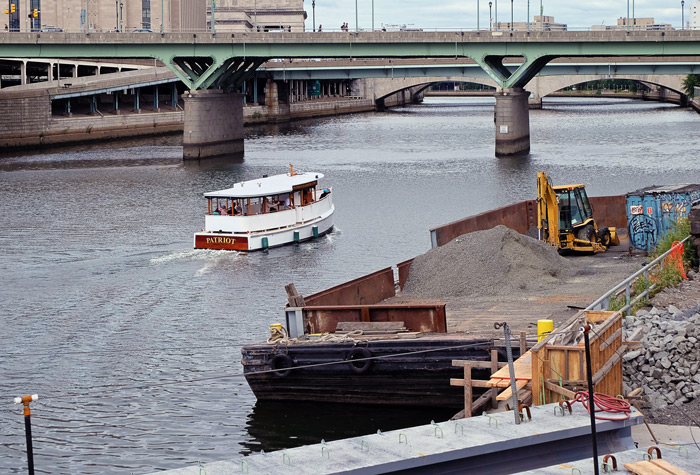 The little Patriot tour boat chugs up the Schuylkill toward the Walnut and Chestnut Street bridges.
The little Patriot tour boat chugs up the Schuylkill toward the Walnut and Chestnut Street bridges.
Visible in the lower righthand corner is construction work on a new boardwalk which will extend the Schuylkill Banks foot path and bike trail out over the river from Center City toward South Philly. "They" say the boardwalk should open in about a year.
Oct 16, 2013
Oct 28, 2013
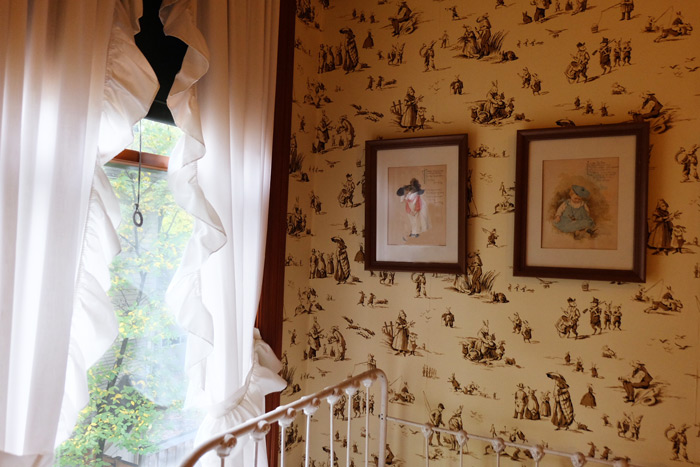 Maud Humphrey, born in 1868 in upstate New York, educated at New York City's new Art Students League and then, of course, in Paris, was a rare creature in her place and time: a highly successful professional woman who managed to combine a brilliant career with conventional marriage and family life. She married a doctor but out-earned him several times over, producing commercial artwork for immensely popular books, magazines, and advertising campaigns; she specialized in sentimental watercolor illustrations that featured plump children and adorable animals. Think: Gerber baby.
Maud Humphrey, born in 1868 in upstate New York, educated at New York City's new Art Students League and then, of course, in Paris, was a rare creature in her place and time: a highly successful professional woman who managed to combine a brilliant career with conventional marriage and family life. She married a doctor but out-earned him several times over, producing commercial artwork for immensely popular books, magazines, and advertising campaigns; she specialized in sentimental watercolor illustrations that featured plump children and adorable animals. Think: Gerber baby.
Oct 30, 2013
 Some of our neighbors are already in the Halloween spirit, or some kind of spirit. Above: Frank "Pope Francis" Schlupp and Carolyn "Sister Mary Catherine" Duffy.
Some of our neighbors are already in the Halloween spirit, or some kind of spirit. Above: Frank "Pope Francis" Schlupp and Carolyn "Sister Mary Catherine" Duffy.
Nov 3, 2013
By the sackful at Gavin's Cafe near Schuylkill River Park.
Nov 6, 2013
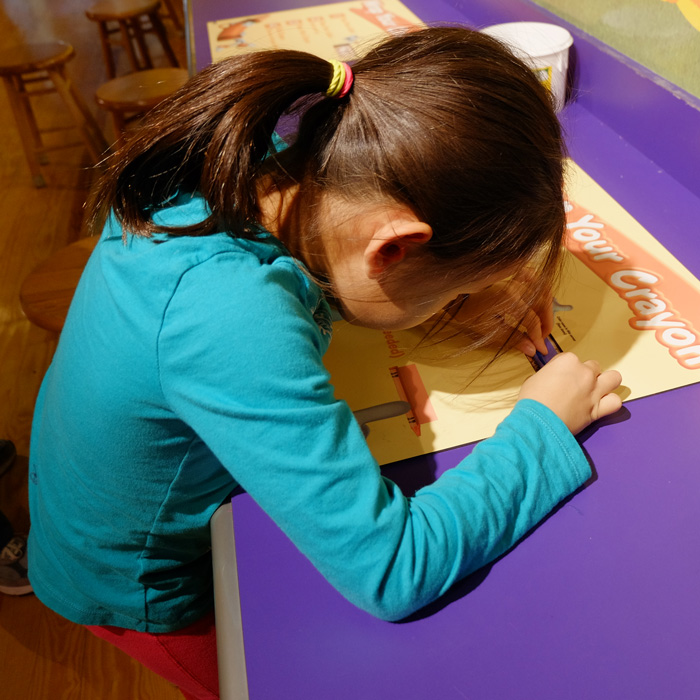 Lily wraps one of her custom-created alliterative labels around a naked crayon at Crayola's play park in Easton, PA. Among her names for crayon colors: Lily Lemon, Lily Lollipop, Marvelous Mom, and Naughty Norman.
Lily wraps one of her custom-created alliterative labels around a naked crayon at Crayola's play park in Easton, PA. Among her names for crayon colors: Lily Lemon, Lily Lollipop, Marvelous Mom, and Naughty Norman.
In the huge Crayola factory just outside of Easton, where all 64 colors are melted and molded and labeled and boxed and shipped out to the world, the wrapping of labels is of course done by machine. But until the wrapping machines came on line in the late 1930s, that part of the process was farmed out to families in the Easton area, who would work at their kitchen tables wrapping labels around each crayon individually for a piecework wage. Each family worked on a single color, and the delivery routes were organized by color: e.g., turn left at the Green house and go up the hill to the Blue place.
Modern crayons first showed up at the 1904 World's Fair in St. Louis, where Crayola exhibited them as "dustless chalk," a healthful innovation for the classroom. The company that made them, Binney & Smith, was getting a little out of its comfort zone, since its main facility in Easton was a slate quarry, which provided slates for schoolrooms utilizing the non-dustless kind of chalk.
Today, Crayola's theme park and factory undergird the economy of Easton, which was once home as well to the headquarters of another corporation manufacturing the stuff American childhood used to be made of: Dixie Cups.
Nov 16, 2013
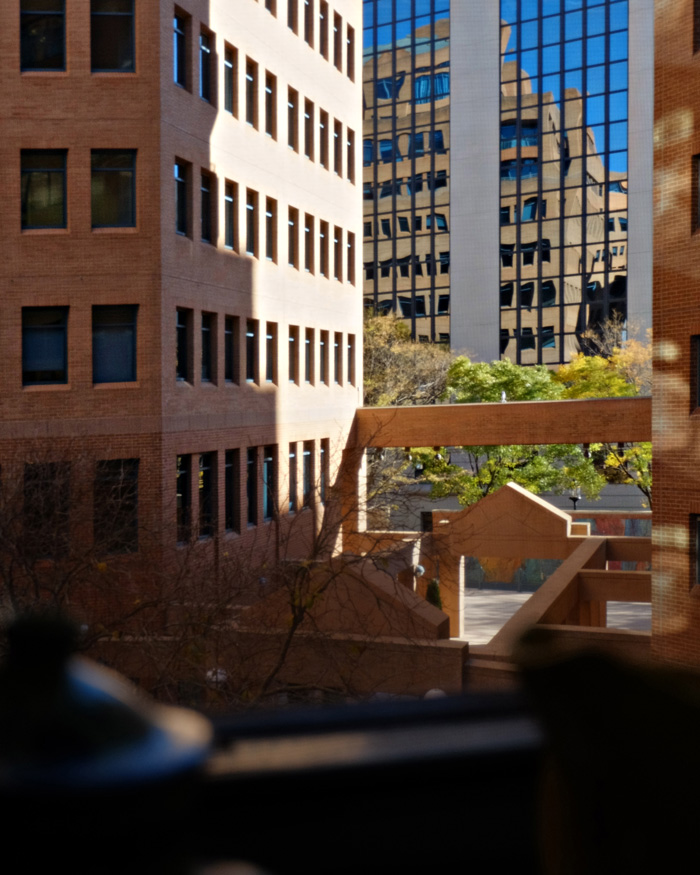 In the morning, in Bethesda, Maryland.
In the morning, in Bethesda, Maryland.
My mother-in-law's window also offers a fine view.
Nov 10, 2013
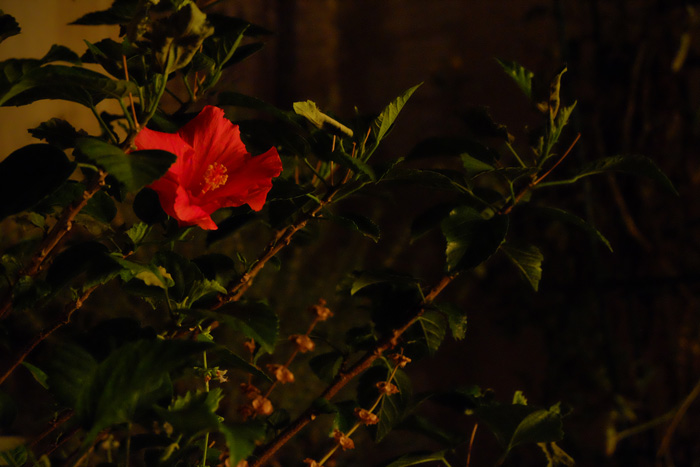 We shot this picture at night because well-mannered hibiscus flowers fold up and die at night, after just a single day of wide-open gorgeousness. This bloom's behavior is out of line; it has glowed like this for four or five days and nights now, and it shows no sign of giving up.
We shot this picture at night because well-mannered hibiscus flowers fold up and die at night, after just a single day of wide-open gorgeousness. This bloom's behavior is out of line; it has glowed like this for four or five days and nights now, and it shows no sign of giving up.
We should note that it's cold outside, downright frosty at night. And well-mannered hibiscus plants don't bloom at all in November in Pennsylvania. They give up and die.
There are no more buds on this plant, and many of the leaves have dropped now, or curled up, or turned brown and crunchy. So when this flower goes, that's it; the show's over. But what a show.
In richness and boldness of color as well as in longevity, this last swan song of a flower really outdid the pale, delicate blooms of summer. But oddly, perhaps, if we carefully compare the hibiscus flower of November with a flower from the same plant back in July, it becomes apparent that this new all-night, all-weather blossom is missing its male parts. And that's all there is to say about that.
Nov 21, 2013
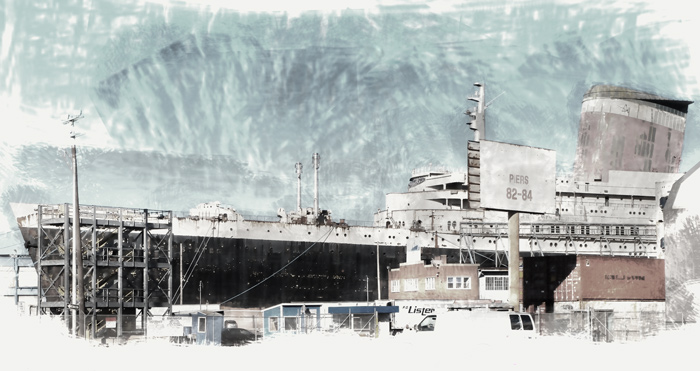 Down at the far edge of South Philly, in the land of the Big Box Stores, floats the biggest box of them all, the old SS United States.
Down at the far edge of South Philly, in the land of the Big Box Stores, floats the biggest box of them all, the old SS United States.
She was the biggest and most luxurious ocean liner ever built, more than 100 feet longer than the Titanic. There is more aluminum in her hull than in anything else on the planet. When she traversed the locks in the Panama Canal, there was just two feet of clearance on either side.
On her maiden voyage in 1952, she shattered the trans-Atlantic speed records in both directions. But 1952 was near the wrong end of the era of gilded passenger liners, and the SS United States has now spent more than half her life quietly rusting away at pierside in Philadelphia, across the street from an Ikea store that could probably fit comfortably in her ballroom.
That's an exaggeration. Most likely, her ballroom could only hold Best Buy.
Nov 23, 2013
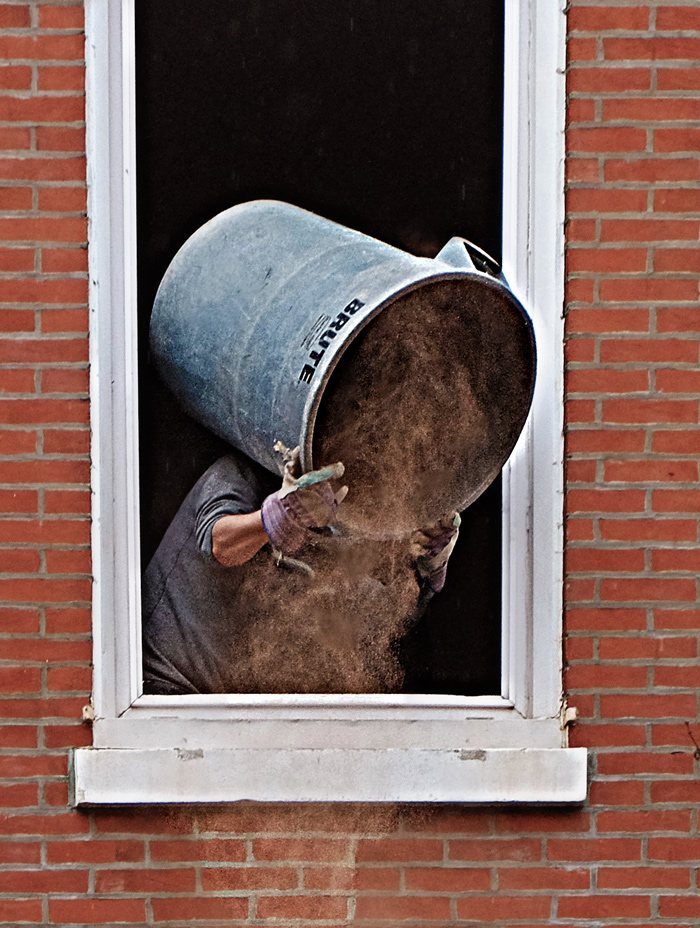 They're gutting yet another house in the neighborhood.
They're gutting yet another house in the neighborhood.
Nov 24, 2013
Thanks to the work of this volunteer and many hundreds of others, Philadelphia got 850 new street trees on Saturday, bringing the overall regional total of trees planted to–according to the calculations of somebody or other, as of Saturday night–exactly 262,236.
The goal is a million new trees, in hopes of restoring the forest canopy area heareabouts to 30%, which would provide enough shade to significantly mitigate the urban heat-island effect and would improve air and water quality, reduce erosion and water pollution, and lessen the frequency and severity of flooding.
The tree roots at bottom right in this photo belong to a variety of maple tree that is particularly hardy in urban settings and has a growth habit suitable for its new home in the urban jungle on South 21st Street, in front of a dentist's office and across the street from a dry cleaner's.
Dec 28, 2013
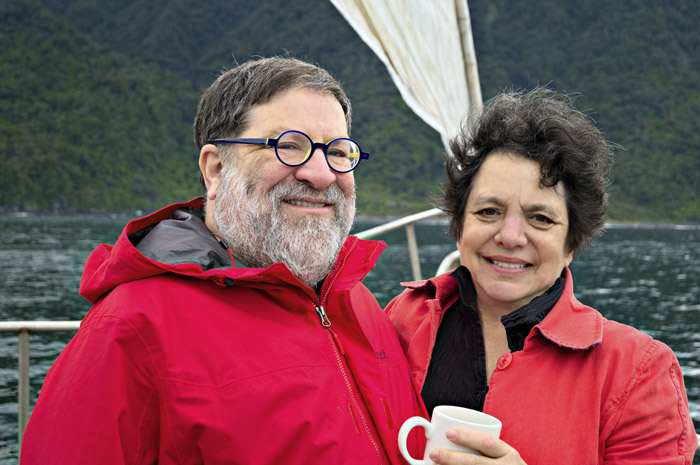
Jan 2, 2014
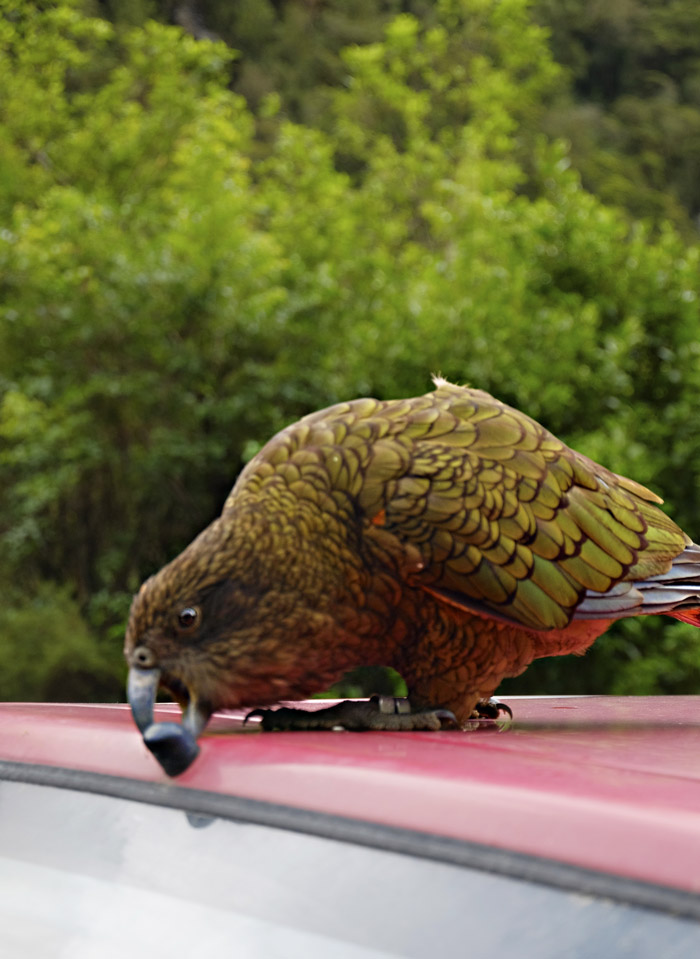 New Zealand is a kingdom of birds. Evolution provided the land with no big predators–in fact, no mammals at all except for a few tiny bats. Birds ruled. They didn't even need to fly to live safely and well in New Zealand; flightless birds–penguins, kiwis, and nine species of giant moa, among many others–found food and nesting sites right on the ground all over the place.
New Zealand is a kingdom of birds. Evolution provided the land with no big predators–in fact, no mammals at all except for a few tiny bats. Birds ruled. They didn't even need to fly to live safely and well in New Zealand; flightless birds–penguins, kiwis, and nine species of giant moa, among many others–found food and nesting sites right on the ground all over the place.
Humans arrived with guns and quickly shot all the moas. Also, people began harassing the other birds with imported varmints that ate eggs and/or birdmeat. We are a pretty pathetic excuse for a species.
But some of the birdlife seems to have evolved to seek a certain revenge. Case in point is the kea, the world's only alpine parrot, endemic to New Zealand's high country. Wherever roads lead to mountain passes or overlooks, keas are hanging out in the parking lots, waiting for cars to chew.
Keas gnaw on and can completely destroy the rubber fittings on automobiles, such as gaskets around windows and antennas. They also eat ice cream a scoop at a time off a handheld cone, and they can figure out how to open backpacks and devour all the food inside.
Jan 6, 2014
 After devoting an entire snow day to building herself a Lego boat, Lily determines that the crowning touch will be a banana.
After devoting an entire snow day to building herself a Lego boat, Lily determines that the crowning touch will be a banana.
Jan 7, 2014
 Joe and Dobby hog all the blankets.
Joe and Dobby hog all the blankets.
Jan 8, 2014
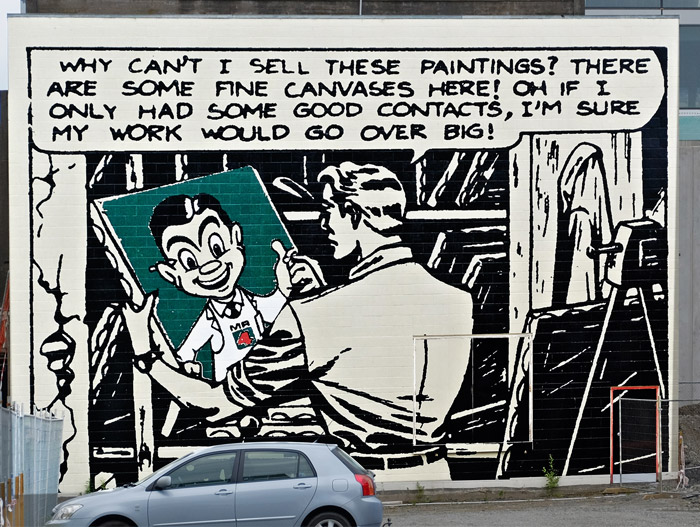 The little guy here in the white apron, with a pencil behind his ear–that's Mr. 4, the grocer-mascot of New Zealand's ubiquitous Four Square chain of supermarkets.
The little guy here in the white apron, with a pencil behind his ear–that's Mr. 4, the grocer-mascot of New Zealand's ubiquitous Four Square chain of supermarkets.
The mural featuring Mr. 4 covers a side wall of the art museum in Christchurch. The museum is closed at the moment and has been for a couple of years. All the artwork currently on exhibit is out in the streets of the city, like this piece.
Perhaps you are wondering why in the picture below there's a crane on top of the museum? Hold that thought; we'll get to it soon.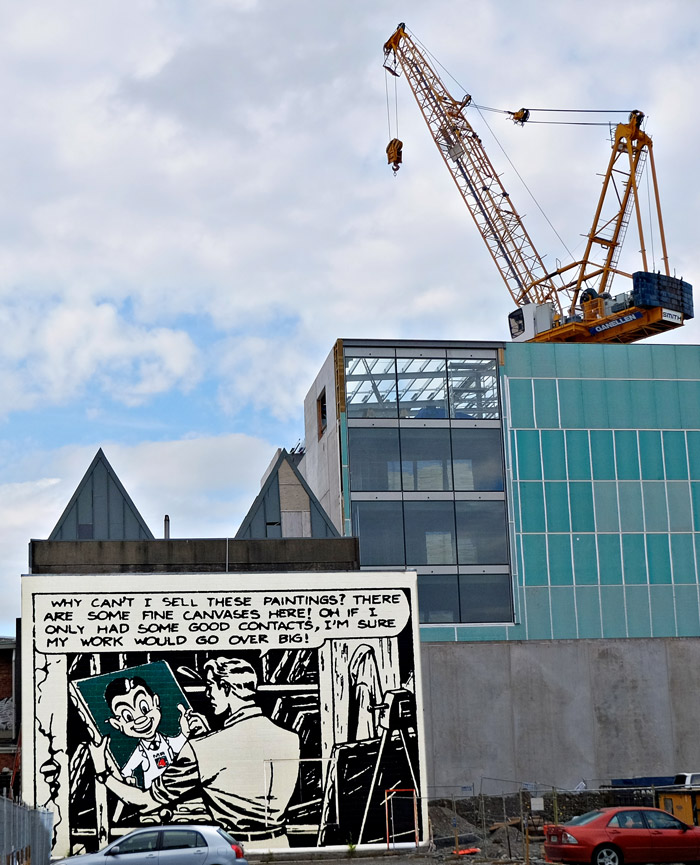
Jan 11, 2014
 On 22 February 2012, white-painted chairs were set up alongside busy Cashel Street in Christchurch, New Zealand, each one different from the others, all of them empty. They covered a freshly sodded swath of a freshly vacant lot, where Baptists used to go to church before an 18-second-long earthquake took out the church, along with about 8,000 other buildings in town.
On 22 February 2012, white-painted chairs were set up alongside busy Cashel Street in Christchurch, New Zealand, each one different from the others, all of them empty. They covered a freshly sodded swath of a freshly vacant lot, where Baptists used to go to church before an 18-second-long earthquake took out the church, along with about 8,000 other buildings in town.
The chairs memorialize the 185 residents of Christchurch who died in the quake. One hundred fifteen of them were in a six-story office building that day across the street from what is now the memorial; in 18 seconds, the building pancaked and caught fire.
The chairs appeared one year to the day after the quake. Like so much else in the city's recovery from the disaster, the chair memorial, designed by Peter Majendie, was planned as transitional and very temporary, to remain on display for a week.
It's still there. Believe it or not, vandals steal chairs from the memorial every now and then, but so far at least, they've been replaced.
This transition stuff can be tough. New Zealand's latest census figures came out last month, revealing that more than 40,000 people have left Christchurch since the earthquake. The city is no longer the country's second largest. The official estimate now is that recovery will take twenty years, minimum.
Here is how people in Christchurch described the quake to us: the earth heaved straight upward, we were told, and then plummeted, slamming back down. Eyewitnesses reported seeing people literally thrown up into the air.
The next several posts will look at what's going on there nowadays, a little less than three years later.
Jan 16, 2014
 Public restroom on Queen's Wharf in Wellington, New Zealand.
Public restroom on Queen's Wharf in Wellington, New Zealand.
Jan 20, 2014
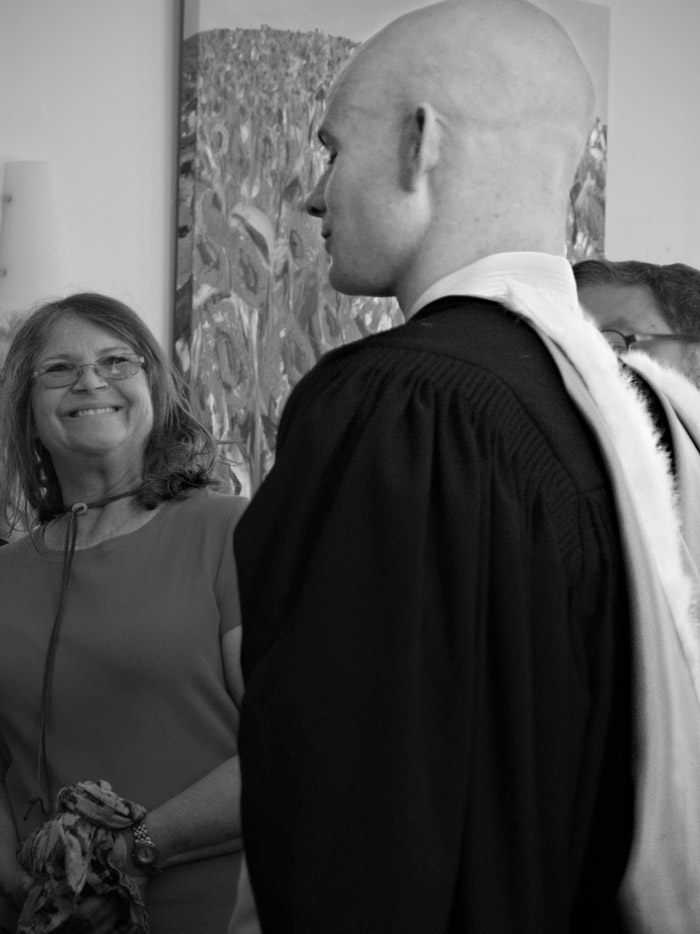 Faculty members of Otago University in Dunedin, New Zealand, go the whole nine yards when it comes to academic regalia for graduation ceremonies, such as the commencement we happened upon last month.
Faculty members of Otago University in Dunedin, New Zealand, go the whole nine yards when it comes to academic regalia for graduation ceremonies, such as the commencement we happened upon last month.
We met this academician while waiting in line at a sandwich shop near campus. Arleigh, our kiwi sister-in-law, was clearly enjoying the chance to converse with him.
He was a professor of physical education, we were told, with particular research and teaching interests in the emerging new discipline of parkour.
Jan 21, 2014
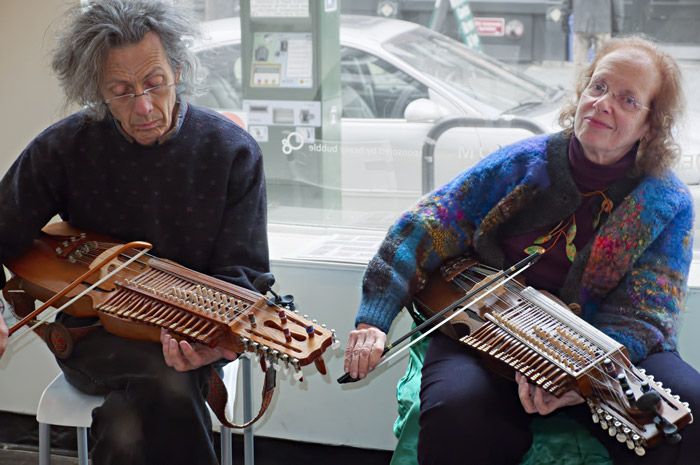 On Sunday afternoon, there was nyckelharpa music in the air at Third Street Gallery on Second Street (don't ask) in Philadelphia's Old City.
On Sunday afternoon, there was nyckelharpa music in the air at Third Street Gallery on Second Street (don't ask) in Philadelphia's Old City.
That doesn't happen too often in Philly or really anywhere in the United States, with the possible exception of the Seattle area, home to the American Nyckelharpa Association and site of occasional dance evenings accompanied by nyckelharpists.
In Sweden, on the other hand, there are an estimaed 10,000 nyckelharpa players, and the keyed fiddle is featured on the back of the 50-krona note and has in fact been declared the country's official musical instrument. Swedes have been building and playing and composing music for nyckelharpor for more than six hundred years. Five-hundred-year-old stained glass windows feature angels playing the nyckelharpa.
The modern version of the instrument has 16 strings, 4 of which are played by the bow; the other 12 vibrate sympathetically, producing a resonant, vaguely organ-like sound.
The bowed string on the upper side of the neck, closest to the player's body, is a drone, unaffected by the keys and used rarely. The other three bowed strings can be shortened by pressing different keys to produce several octaves' worth of tones; there are three rows of keys, each dedicated to a different string.
Most nyckelharpa music harks back to folksong or polka, but the instrument is used by a handful of Swedish rock bands, and some serious musicians can play pretty much anything on it, such as Bach's Partita No. 2 in D Minor.
The nyckelharpa occasion on Sunday was a reception for an art show featuring two Philly-area artists: Judith Schermer, who exhibited twelve paintings of clotheslines, and Priscilla Snow Algava, who showed a variety of drawings and paintings of "matriarchs and sages."
Jan 22, 2014
 On a day like this, all the neighborhood cats stayed indoors snoozing by the heater.
On a day like this, all the neighborhood cats stayed indoors snoozing by the heater.
Jan 23, 2014
Jan 24, 2014
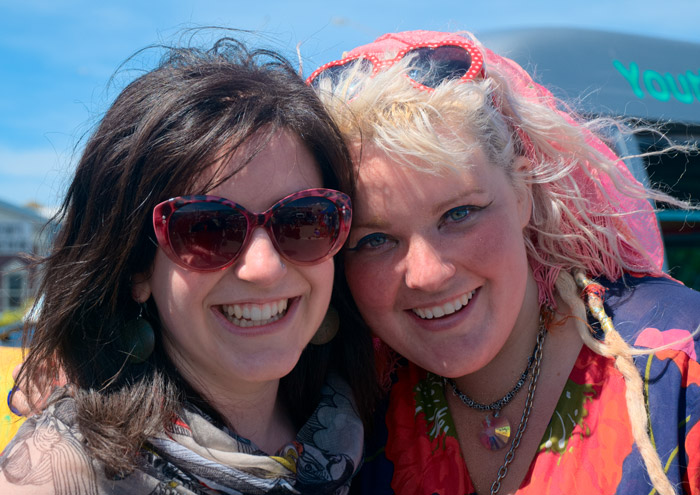 Our niece Avi, in shades, and her friend Tahu put their heads together in the noonday sun at the farmers' market in Dunedin, New Zealand. Tahu had a singing gig at the market that day, with her band Tahu and the Takahes.
Our niece Avi, in shades, and her friend Tahu put their heads together in the noonday sun at the farmers' market in Dunedin, New Zealand. Tahu had a singing gig at the market that day, with her band Tahu and the Takahes.
Feb 7, 2014
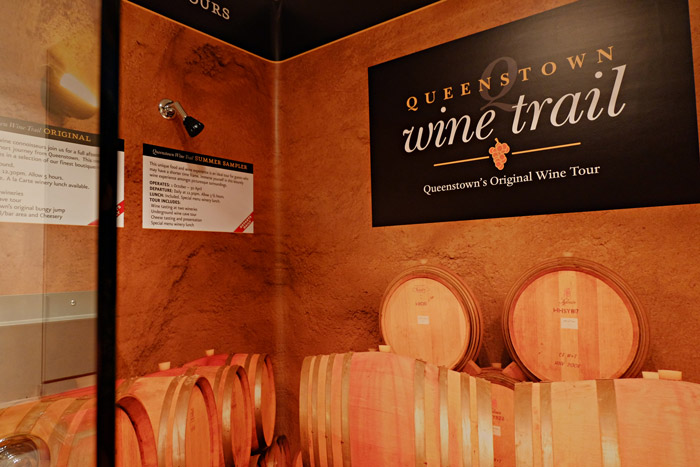 In Sochi, we're told, the Russian government spies on you while you're in the shower. Well, in Queenstown, New Zealand, corporations try to sell you stuff while you're in the shower; the walls of the shower stall at our "holiday park" were papered over with ads for, in this case, winery tours.
In Sochi, we're told, the Russian government spies on you while you're in the shower. Well, in Queenstown, New Zealand, corporations try to sell you stuff while you're in the shower; the walls of the shower stall at our "holiday park" were papered over with ads for, in this case, winery tours.
Feb 8, 2014
 Conceded: the sun was already below the horizon when it did all this to the sky the other day. Say it set ten or fifteen minutes earlier, around 5:30 PM.
Conceded: the sun was already below the horizon when it did all this to the sky the other day. Say it set ten or fifteen minutes earlier, around 5:30 PM.
5:30's not bad. Really. We don't have to pay any attention to that groundhog behind the curtain: spring is coming.
Still have to wear a coat, though.. . .
Feb 9, 2014
 Sadly, what this train is hauling is the kind of stuff that keeps us warm. We have to do something about this.
Sadly, what this train is hauling is the kind of stuff that keeps us warm. We have to do something about this.
Feb 10, 2014
 Apparently, these tourists in Queenstown, New Zealand, have no intention of sharing their Fergburgers with attentive local ducks.
Apparently, these tourists in Queenstown, New Zealand, have no intention of sharing their Fergburgers with attentive local ducks.
Feb 17, 2014
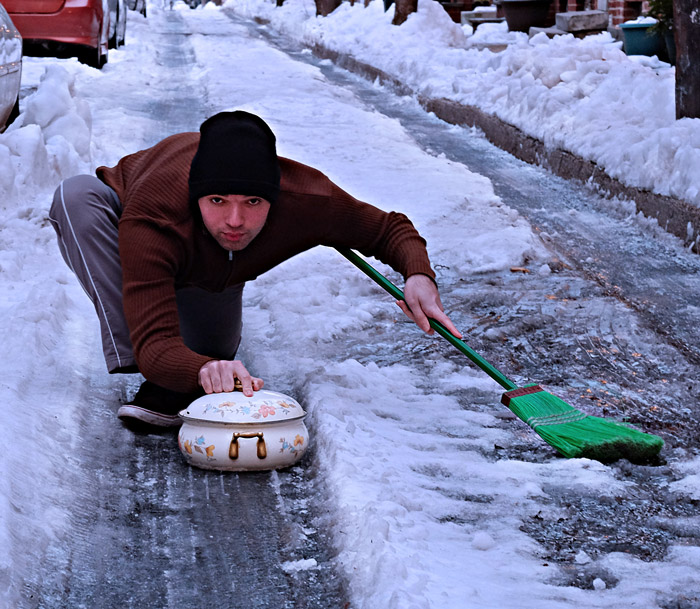 Marco's rock is right on track for the U.S. of A.
Marco's rock is right on track for the U.S. of A.
Feb 19, 2014
Feb 21, 2014
 When we returned from New Zealand late last year, we were particularly eager to share pictures of the really interesting, stretch-of-the-imagination stuff we'd encountered there: car-eating parrots, cardboard cathedrals, a parkour professor, and of course an awesome ukelele wedding.
When we returned from New Zealand late last year, we were particularly eager to share pictures of the really interesting, stretch-of-the-imagination stuff we'd encountered there: car-eating parrots, cardboard cathedrals, a parkour professor, and of course an awesome ukelele wedding.
We'd set out for New Zealand hoping for this sort of serendipity but knowing for sure we'd see scenery: mountains, waterfalls, forests of hobbity vegetation, cities with flowers, beaches and cliffs, and, of course of course, sheep. We lucked out with all of that as well.
And needless to say, we got pictures.
So for the next little while, we'll share some shots of the real New Zealand, beginning tomorrow with The Silver Fern
Feb 22, 2014
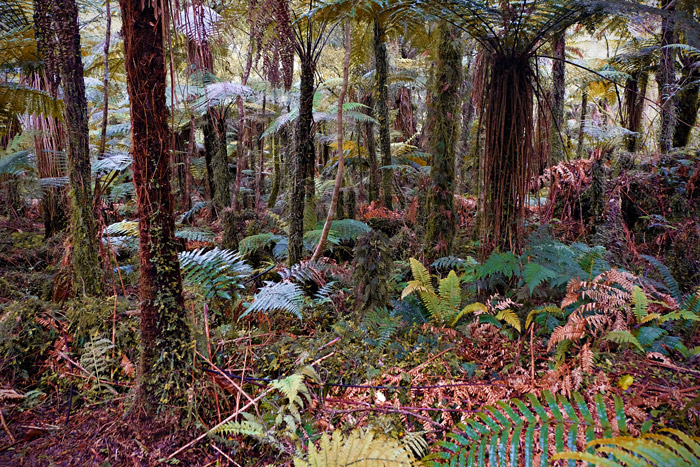 New Zealand is a land of ferns, notably of tree ferns, which give many Kiwi forests a certain Jurassic Park sort of character. And of course it is also the land of the silver fern, which is botanically one of the endemic tree ferns and artistically an abstracted swirl of a fern frond, as much corporate-style logo as patriotic emblem.
New Zealand is a land of ferns, notably of tree ferns, which give many Kiwi forests a certain Jurassic Park sort of character. And of course it is also the land of the silver fern, which is botanically one of the endemic tree ferns and artistically an abstracted swirl of a fern frond, as much corporate-style logo as patriotic emblem.Feb 28, 2014
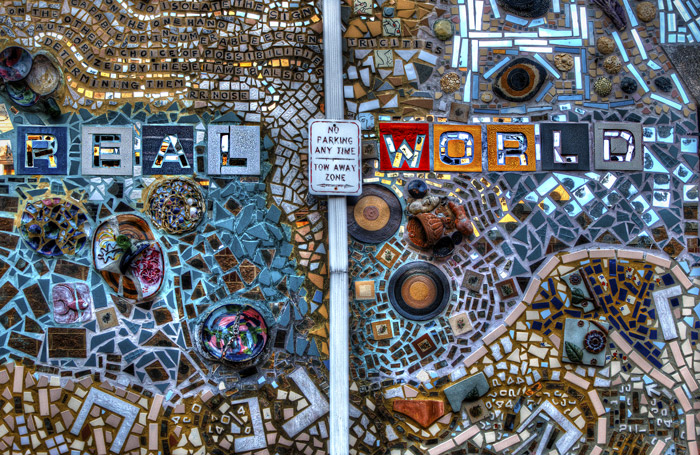 Isaiah Zagar's Magic Gardens in Philadelphia is a compound of galleries and courtyards devoted to Zagar's obsessive mosaicking of every square inch of everything.
Isaiah Zagar's Magic Gardens in Philadelphia is a compound of galleries and courtyards devoted to Zagar's obsessive mosaicking of every square inch of everything.
Here on the outer side of the wall surrounding the place, we see a sign on a drainpipe that clarifies what's important to life outside the magic garden
Mar 9, 2014
 Dressed perfectly for an outing to the Philadelphia Flower Show, and willing to pose for a picture if the photographer's really, really quick.
Dressed perfectly for an outing to the Philadelphia Flower Show, and willing to pose for a picture if the photographer's really, really quick.
Mar 11, 2014
 Back in March 1866, Greymouth was a rough little gold rush town on New Zealand's wild west coast, crowded with young men scheming to get rich quick, many of them immigrants from Ireland. While most of the town celebrated St. Patrick's Day that year, a man named Synder Browne huddled in a tent near the muddy outskirts of town, setting type by hand for the first edition of Greymouth's second newspaper, the Evening Star.
Back in March 1866, Greymouth was a rough little gold rush town on New Zealand's wild west coast, crowded with young men scheming to get rich quick, many of them immigrants from Ireland. While most of the town celebrated St. Patrick's Day that year, a man named Synder Browne huddled in a tent near the muddy outskirts of town, setting type by hand for the first edition of Greymouth's second newspaper, the Evening Star.
Greymouth's first paper, already a year old by then, was the Grey River Argus, which would become a Socialist tabloid. For the next century, the left-wing Argus and the right-wing Star would duke it out in the local marketplace of public opinion; their editors, it was said, took opposing positions on absolutely every public issue. Only once a year, on Christmas Eve, would the two editors get together for a holiday drink and some collegial conversation. Every other day of the year they spat and fussed in the competition for readers and for influence over Greymouth's affairs.
The town survived the gold rush, thanks to another mineral that had actually been discovered earlier but was initially ignored because it didn't glitter like you-know-what: coal. There was plenty of coal in the hillsides around Greymouth, though all the customers for coal, and all the ports suitable for coal shipping, were hundreds or thousands of kilometers away on the other side of the Southern Alps. Greymouth was a seaside town but without a decent harbor; it sat rough and damp in the nearly uninhabited rainforest along the west coast of New Zealand's South Island. To make a go of coal mining thereabouts, somebody was going to have to build a railroad over the mountains.
The Argus and the Star had different ideas about Greymouth's economic development. They argued for different people to pay for, and benefit from, the railroad project. When coal mining became established, the two papers argued even more fiercely over mine safety and environmental issues. The mines there have been productive but quite dangerous, with high concentrations of coalbed methane. Many miners have died over the years in mine fires and explosions, and several mine projects have been abandoned after methane levels proved uncontrollable. The Argus and the Star told different stories about the tragedies.
Most mines are closed now, and the town survives on forestry work and tourism; it is a portal to the glacier and fjord country further south. The population has leveled off at about 5,000, and there's only one newspaper left, the Greymouth Star. The Argus folded in the 1960s.
Today, the Star is owned by a publishing conglomerate based in Dunedin. And even though print media is in big trouble all over the world, the Star is hanging on, with subscribers all along the west coast and a workforce of more than 60 fulltime employees.
The Star is available online as well as on paper. In the latest edition, you can read about Charles Edward Miller Pearce, a New Zealand–born mathematician who taught at Adelaide University in Australia. He came home for a visit, rented a car at the Hokitika airport, just south of Greymouth, then drove south on the coastal highway until he apparently lost consciousness. His car landed upside down in shallow water, with only his head submerged.
"If he had been conscious, all he would have had to do was turn his head towards the middle of the car," a witness told the coroner, according to the Star's report, "and his face would have been out of the water."
"I observed that he had a peaceful expression on his face," noted a second witness. "My guess was that he fell asleep at the wheel and never woke up."
Mar 23, 2014
 It's been the proverbial March so far, but we must be up around LANE if not even LAME by now.
It's been the proverbial March so far, but we must be up around LANE if not even LAME by now.
LION
LOON
LORN
LORE
LONE
LANE
LAME
LAMB
Apr 2, 2014
 On his knees all day long, making the city a better place.
On his knees all day long, making the city a better place.
Apr 8, 2014
 Lots of weather delays Sunday at the Birmingham airport.
Lots of weather delays Sunday at the Birmingham airport.
Apr 10, 2014
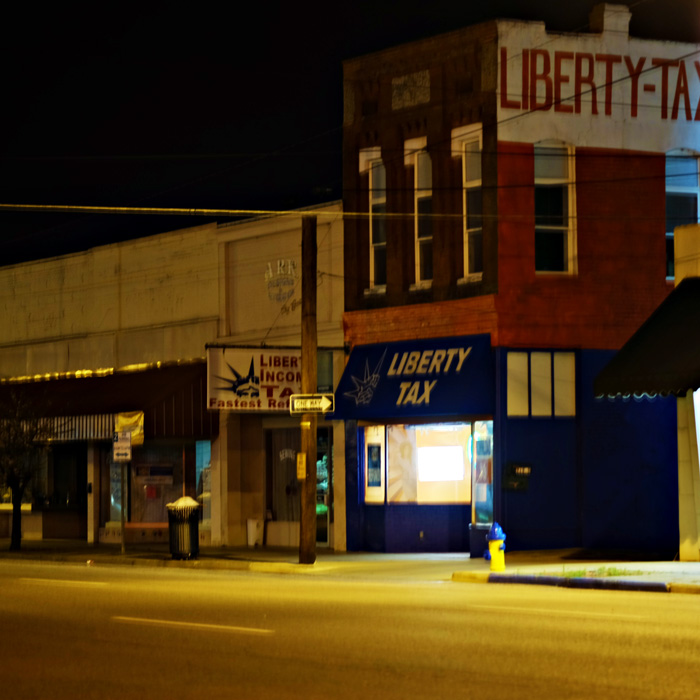 By eleven o'clock on a Friday night, the streets of downtown Bessemer, Alabama, are empty, and the town looks dead. Even the Bright Star Restaurant is closed for the night.
By eleven o'clock on a Friday night, the streets of downtown Bessemer, Alabama, are empty, and the town looks dead. Even the Bright Star Restaurant is closed for the night.
The only thing open, it seems, at least on this block of 19th Street in Bessemer, is the office of Liberty Tax preparers. Wonder why the folks in there are burning the midnight oil?
Apr 21, 2014
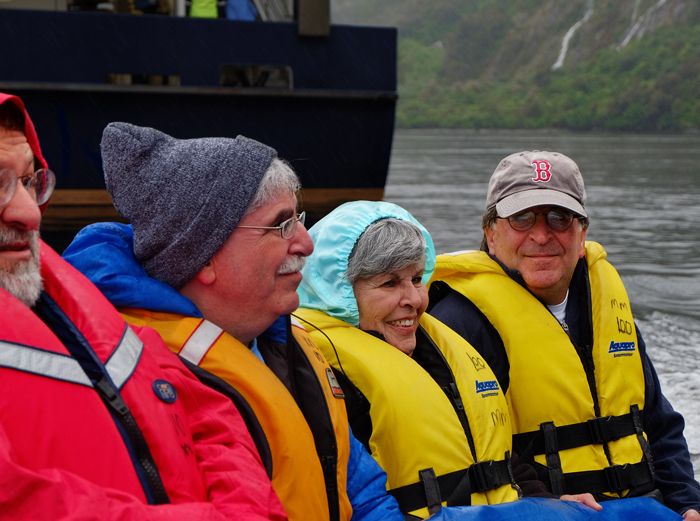 Here in a Zodiac, scooting across Milford Sound, a fjord on New Zealand's remote southwest coast, on a cold wet summer day this past December, is Helen Ruskin Stein Behr with her three sons. Not pictured is her daughter, who visited Milford Sound a few days earlier.
Here in a Zodiac, scooting across Milford Sound, a fjord on New Zealand's remote southwest coast, on a cold wet summer day this past December, is Helen Ruskin Stein Behr with her three sons. Not pictured is her daughter, who visited Milford Sound a few days earlier.
The impetus for the journey to New Zealand was the awesome wedding of one of the granddaughters, Gillian, who emigrated to New Zealand seven years ago with her parents, Richard and Arleigh, and her sister Avi.
Today is Helen's birthday, as she turns eighty-something-and-who's-counting, to our great joy. Wishing her many happy returns of the day.
Apr 25, 2014
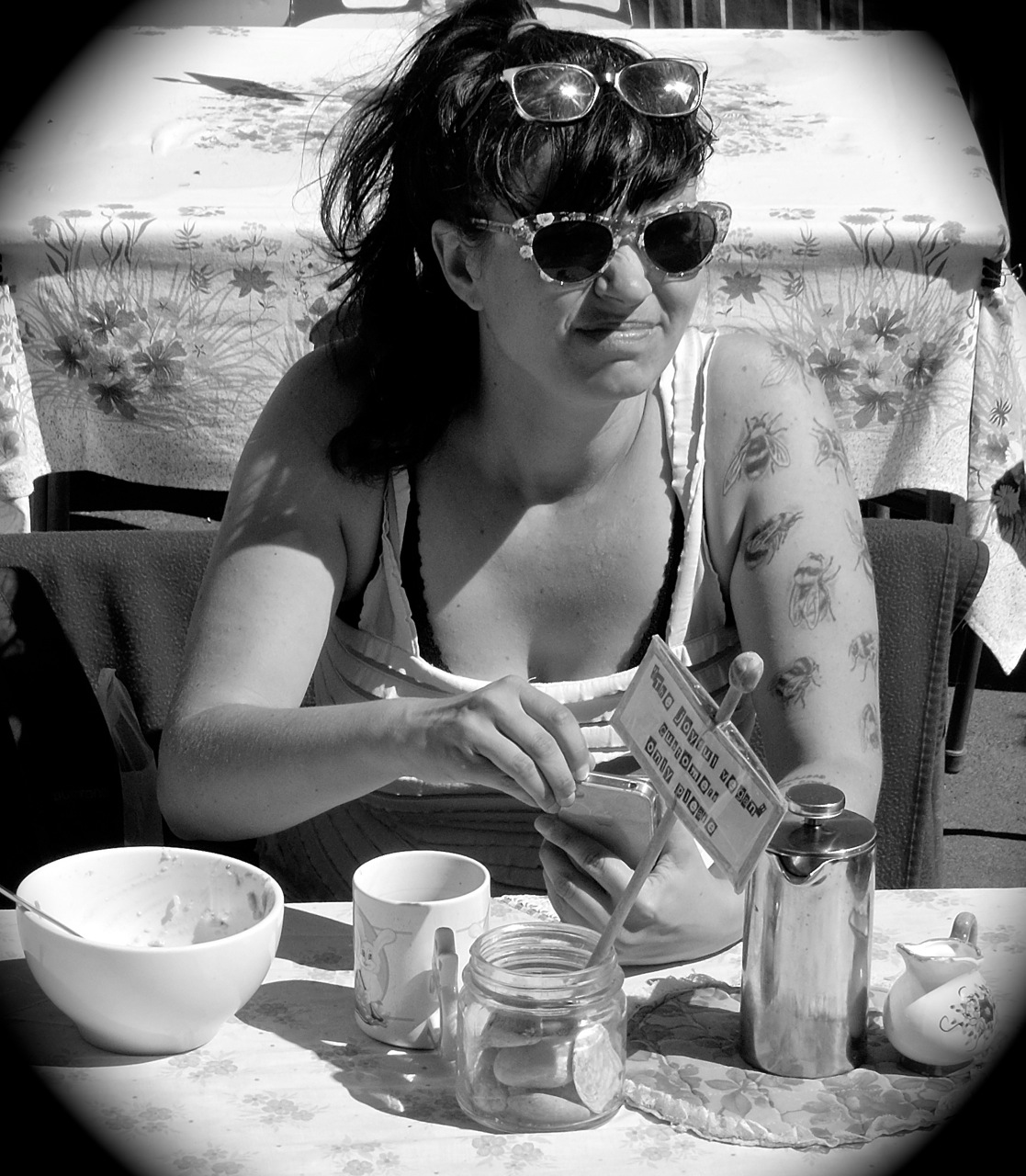 Looks like she's finished her lunch at the Joyful Vegan booth in the Saturday farmers' market next to the train station in Dunedin, New Zealand.
Looks like she's finished her lunch at the Joyful Vegan booth in the Saturday farmers' market next to the train station in Dunedin, New Zealand.
The bumblebees on her left arm raise some interesting issues. Are they about honey and sweetness? Or stinging and pain? Or flight? Or queens or flowers or buzzing or hives?
Apr 26, 2014
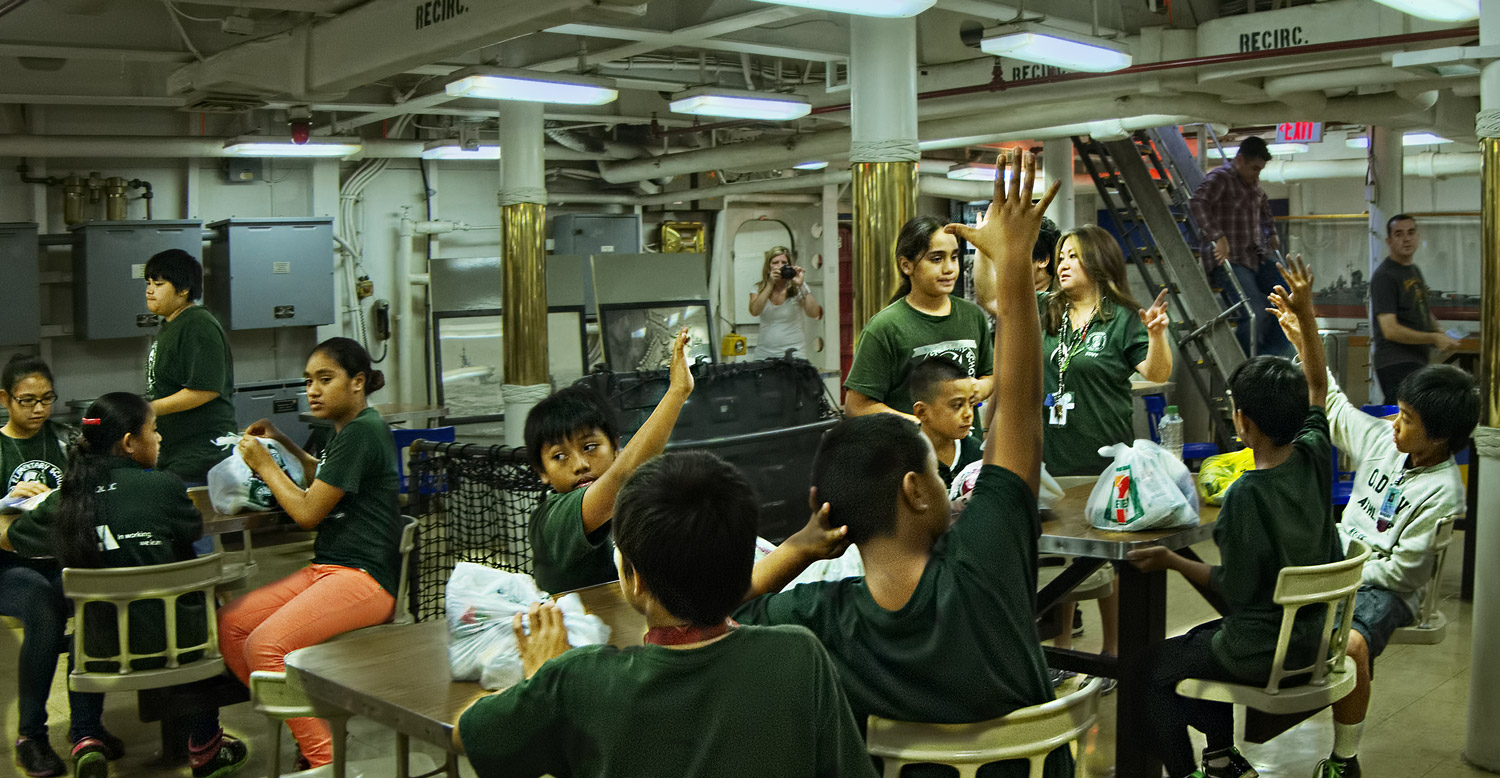 Some of the middle school students participating in their class field trip to the battleship USS Missouri in Pearl Harbor, Hawaii, appear enthusiastically prepared to answer their teacher's question. Of course the question might be: Who's ready for lunch?
Some of the middle school students participating in their class field trip to the battleship USS Missouri in Pearl Harbor, Hawaii, appear enthusiastically prepared to answer their teacher's question. Of course the question might be: Who's ready for lunch?
The students are seated in one of several mess halls deep in the ship; several ladders above them is the deck where the Japanese surrendered on September 2, 1945, to Gen. Douglas MacArthur and representatives of all the Allied powers, finally ending World War II. The American flag flown that day at the ceremony had only 31 stars and was hung backwards, stars at upper right; it was the original flag brought to Tokyo by Admiral Perry in 1853 when Japan was first opened to international trade, and it had frayed so badly over the years that one side of it–the right side–was sewed over with a protective linen covering, leaving only the reverse side for display.
Just below the deck where the ceremony took place is a dented spot in the hull. Six months before the surrender, during the bombardment of Okinawa, a kamikaze pilot had crashed into the Missouri, losing a wing off his plane and starting a gasoline fire aboard ship. The fire was quickly put out, and the ship was only dinged, not seriously damaged; the pilot, however, did not survive. The story is that the Missouri's captain, William Callaghan, had to rescue the pilot's corpse from sailors attempting to summarily dispose of it; Captain Callahan insisted on a full funeral service for the pilot, with military honors and burial at sea. The dent in the hull was never repaired.
After World War II, President Truman decommissioned every other battleship in the navy but insisted on maintaining the Missouri in active service, over the objections of military advisors. Battleships had no role to play in postwar navy planning. The Missouri was sent to Korea, however, during that conflict. It was then mothballed–but returned to duty one last time in 1984 during President Reagan's military buildup. It provided artillery support during the First Gulf War before being finally deactivated.
Since 1998, the Missouri has been a major tourist attraction at Pearl Harbor, as well as a school field trip destination. And there's plenty on board for the schoolchildren to see: big guns, tall stacks of bunks, signs insisting on short showers while at sea, and, of course, the backwards flag and the dent in the hull.
Up top, on deck underneath some of those big guns, a few members of the Marine Band entertained the tourists. The day we and the middle schoolers visited, the band played "Jingle Bell Rock," but now that it's springtime, the setlist has probably changed.
Apr 28, 2014
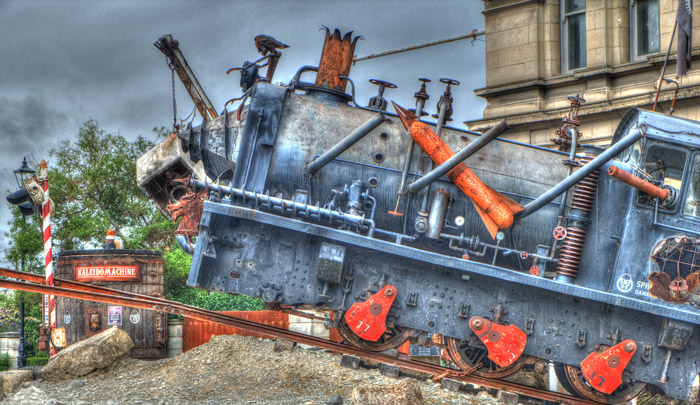 Three hours south of Christchurch on the east coast of New Zealand's South Island is Oamaru, one of the country's oldest cities and briefly–back in the 1870s–one of its wealthiest and fastest growing.
Three hours south of Christchurch on the east coast of New Zealand's South Island is Oamaru, one of the country's oldest cities and briefly–back in the 1870s–one of its wealthiest and fastest growing.
There was a halfway decent harbor for a port to serve the thriving agricultural region, especially after introduction of refrigerated transport for meat. High-quality limestone for building was locally plentiful. A 50-km-long aqueduct was constructed to slake the thirst of the booming little city and irrigate surrounding farmland with fresh mountain water. Industry emerged, lapping up the new water supply. The city built an opera house, an athaeneum, and a large and ornate public garden.
By the 1880s, when economic depression hit hard, Oamaru was said to be "the best built and most mortgaged town in Australasia." The aqueduct went bankrupt, the port closed, industry languished, and construction stopped for more than a hundred years.
What finally saved Oamaru was steampunk, the style of art and/or life that emerged from the punk rock era but is rooted in Victorian-era visions of a fantastic feature: think Jules Verne and H. G. Wells. Steampunk science fiction is inspired by nineteenth-century steam-powered technology and decorative arts, ratcheted up by twenty-first-century irreverence and intensity.
Oamaru's intact nineteenth-century downtown–intact because nobody since the nineteenth century had thought the place worth a dime of investment–created an ideal backdrop for steampunk festivals, steampunk artists' studios, steampunk shopping, and eventually steampunk tourism.
(Oamaru also has penguins, more of which soon. Watch this space.)